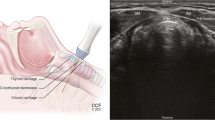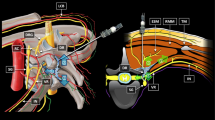Abstract
Purpose
This study was designed to investigate the risk of local anesthetic toxicity and efficacy of simultaneous bilateral axillary brachial plexus block performed under the guidance of ultrasound or a neurostimulator.
Methods
One hundred and twenty patients who were anesthetized with bilateral axillary plexus block simultaneously between February 2012 and March 2014 were enrolled in the study. The patients were anesthetized under the guidance of a neurostimulator (group N, n = 60) or ultrasound (group U, n = 60). The block performance time, procedure-related pain, adverse events, total and free plasma concentrations of ropivacaine, and other data were recorded. The comparison was analyzed statistically.
Results
The block performance time, and onset of the sensory and motor block, of group N was longer than that of group U (p < 0.001). The procedure-related pain of group N was more serious than that of group U (p < 0.05). The patient satisfaction rate of group U was higher than that of group N (p < 0.05). The total plasma concentrations of ropivacaine in group N were comparable to those of group U, except for the value at 50 min after injection (p < 0.05). The free plasma concentrations of ropivacaine of group N at 5 min were significantly higher than that of group U (p < 0.001). No apparent serious adverse events were observed perioperatively in both groups.
Conclusions
Simultaneous bilateral axillary brachial plexus block guided by neurostimulator or ultrasound in bilateral distal upper extremity surgery seems to have a low risk of local anesthetic toxicity and to be effective. The ultrasound-guided block is superior in terms of providing the same degree of anesthesia with shorter duration, less pain, and faster onset of sensory and motor blockades, which is important in clinical practice.



Similar content being viewed by others
References
O’Donnell B, Riordan J, Ahmad I, Iohom G. A clinical evaluation of block characteristics using one milliliter 2 % lidocaine in ultrasound-guided axillary brachial plexus block. Anesth Analg. 2010;111:808–10.
Vassiliou T, Muller HH, Ellert A, Wallot P, Kwee KM, Beyerle M, Eberhart L, Wulf H, Steinfeldt T. High- versus low-stimulation current threshold for axillary plexus blocks: a prospective randomized triple-blinded noninferiority trial in 205 patients. Anesth Analg. 2013;116:247–54.
Janzen PR, Vipond AJ, Bush DJ, Hopkins PM. A comparison of 1% prilocaine with 0.5% ropivacaine for outpatient-based surgery under axillary brachial plexus block. Anesth Analg. 2001;93:187–91.
Koscielniak-Nielsen Z, Rotbøll Nielsen P, Risby Mortensen C. A comparison of coracoid and axillary approaches to the brachial plexus. Acta Anaesthesiol Scand. 2000;44:274–9.
Holborow J, Hocking G. Regional anaesthesia for bilateral upper limb surgery: a review of challenges and solutions. Anaesth Intensive Care. 2010;38:250–8.
Chiang EP, Dangerfield P, Mehta JH, Sherman M, Berger JS. The crucial role of bilateral infraclavicular nerve blocks in the anesthetic management of a trauma patient. Open J Anesthesiol. 2012;2:113–6.
Errando C, Pallardó M, Herranz A, Peiró C, de Andrés J. Bilateral axillary brachial plexus block guided by multiple nerve stimulation and ultrasound in a multiple trauma patient. Rev Esp Anestesiol Reanim. 2005;53:383–6.
Vásquez MI, Jiménez AM, Aguirre OD, González MP, Ríos ÁM. Bilateral ultrasound-guided supraclavicular block. Colomb J Anesthesiol. 2012;40:304–8.
Handoll H, Koscielniak-Nielsen ZJ. Single, double or multiple injection techniques for axillary brachial plexus block for hand, wrist or forearm surgery. Cochrane Database Syst Rev. 2006;25:CD003842.
Sia S, Bartoli M. Selective ulnar nerve localization is not essential for axillary brachial plexus block using a multiple nerve stimulation technique. Reg Anesth Pain Med. 2001;26:12–6.
Koscielniak-Nielsen Z, Stens-Pedersen H, Lippert FK. Readiness for surgery after axillary block: single or multiple injection techniques. Eur J Anaesthesiol. 1997;14:164–71.
Gautier P, Vandepitte C, Ramquet C, DeCoopman M, Xu D, Hadzic A. The minimum effective anesthetic volume of 0.75 % ropivacaine in ultrasound-guided interscalene brachial plexus block. Anesth Analg. 2011;113:951–5.
Casati A, Danelli G, Baciarello M, Corradi M, Leone S, Di Cianni S, Fanelli G. A prospective, randomized comparison between ultrasound and nerve stimulation guidance for multiple injection axillary brachial plexus block. Anesthesiology. 2007;106:992–6.
Qin W, Jiao Z, Zhong M, Shi X, Zhang J, Li Z, Cui X. Simultaneous determination of procaine, lidocaine, ropivacaine, tetracaine and bupivacaine in human plasma by high-performance liquid chromatography. J Chromatogr B. 2010;878:1185–9.
Scott DB, Lee A, Fagan D, Bowler GM, Bloomfield P, Lundh R. Acute toxicity of ropivacaine compared with that of bupivacaine. Anesth Analg. 1989;69:563–9.
Serradell A, Herrero R, Villanueva J, Santos J, Moncho J, Masdeu J. Comparison of three different volumes of mepivacaine in axillary plexus block using multiple nerve stimulation. Br J Anaesth. 2003;91:519–24.
Gelfand HJ, Ouanes JPP, Lesley MR, Ko PS, Murphy JD, Sumida SM, Isaac GR, Kumar K, Wu CL. Analgesic efficacy of ultrasound-guided regional anesthesia: a meta-analysis. J Clin Anesth. 2011;23:90–6.
Ponde VC, Diwan S. Does ultrasound guidance improve the success rate of infraclavicular brachial plexus block when compared with nerve stimulation in children with radial club hands? Anesth Analg. 2009;108:1967–70.
Trabelsi W, Amor MB, Lebbi MA, Romdhani C, Dhahri S, Ferjani M. Ultrasound does not shorten the duration of procedure but provides a faster sensory and motor block onset in comparison to nerve stimulator in infraclavicular brachial plexus block. Korean J Anesthesiol. 2013;64:327–33.
Eichenberger U, Stöckli S, Marhofer P, Huber G, Willimann P, Kettner SC, Pleiner J, Curatolo M, Kapral S. Minimal local anesthetic volume for peripheral nerve block: a new ultrasound-guided, nerve dimension-based method. Reg Anesth Pain Med. 2009;34:242–6.
Latzke D, Marhofer P, Zeitlinger M, Machata A, Neumann F, Lackner E, Kettner S. Minimal local anaesthetic volumes for sciatic nerve block: evaluation of ED99 in volunteers. Br J Anaesth. 2010;104:239–44.
Zhou Y, Zhao Y, Lin H, Wang T. Comparison of blockage effect of axillary brachial plexus block between ultrasound guidance alone and ultrasound guidance plus neurostimulation. Zhonghua Yi Xue Za Zhi. 2013;93:1649–52.
Mao Y, Li J, Li B. Morphological study and clinical significance of skeletal muscle’s motor end plates and motor points in rabbits. Chin J Rehabil Med. 2011;11:009.
Knudsen K, Suurküla MB, Blomberg S, Sjövall J, Edvardsson N. Central nervous and cardiovascular effects of i.v. infusions of ropivacaine, bupivacaine and placebo in volunteers. Br J Anaesth. 1997;78:507–14.
Hickey R, Blanchard J, Hoffman J, Sjovall J, Ramamurthy S. Plasma concentrations of ropivacaine given with or without epinephrine for brachial plexus block. Can J Anaesth. 1990;37:878–82.
Author information
Authors and Affiliations
Corresponding author
Ethics declarations
Conflict of interest
The authors declare that they have no conflict of interest.
About this article
Cite this article
Wang, H., Li, L., Xu, C. et al. The efficacy of simultaneous bilateral axillary brachial plexus block under the guidance of neurostimulator or ultrasound: a prospective study. J Anesth 30, 596–602 (2016). https://doi.org/10.1007/s00540-016-2193-2
Received:
Accepted:
Published:
Issue Date:
DOI: https://doi.org/10.1007/s00540-016-2193-2




